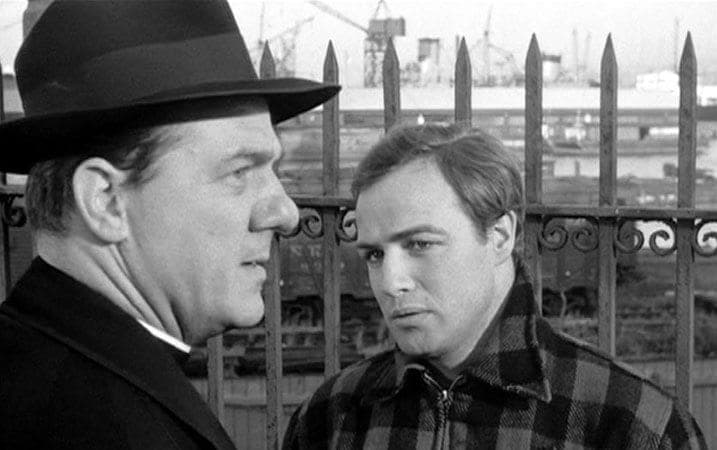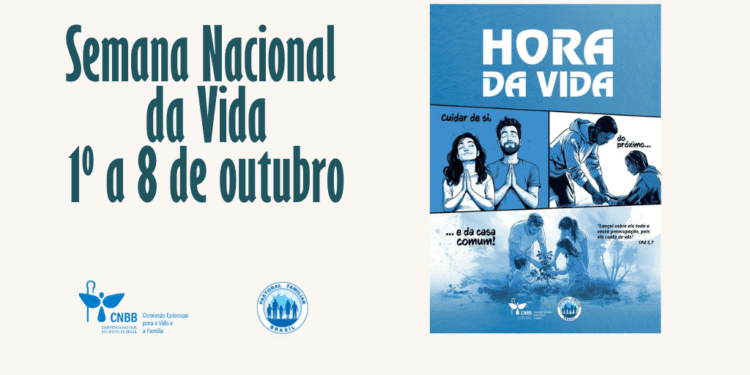Some people think the Crucifixion only took place on Calvary. They better wise up! Taking Joey Doyle’s life to stop him from testifying is a crucifixion. And dropping a sling on Kayo Dugan because he was ready to spill his guts tomorrow, that’s a crucifixion. And every time the Mob puts the pressure on a good man, tries to stop him from doing his duty as a citizen, it’s a crucifixion. And anybody who sits around and lets it happen, keeps silent about something he knows that happened, shares the guilt of it just as much as the Roman soldier who pierced the flesh of our Lord to see if he was dead. Boys, this is my church! And if you don’t think Christ is down here on the waterfront, you’ve got another guess coming!
The celebrated dockside sermon in “On the Waterfront,” delivered by Karl Malden’s Father Barry, is a powerful reminder of the Catholic idea that Good Friday has implications for all human suffering. “By his passion and death on the cross,” the Catechism of the Catholic Church teaches, “Christ has given a new meaning to suffering” (CCC 1505).
“A Jewish friend of mine once asked me, ‘Where was God during the holocaust, when six million Jews were put into gas ovens?’” the prolific Catholic author Peter Kreeft once wrote. “I said that God was in the gas ovens.”
Many Catholics watch some cinematic version of the passion narratives around this time of year — perhaps the last hour or two of Franco Zeffirelli’s “Jesus of Nazareth,” or Mel Gibson’s “The Passion of the Christ.”
But the Crucifixion was not only on Calvary, and if Christ is on the waterfront, he can also be found in a medieval prison cell, a cheap, penny-ante building and loan in a crummy little town, a Russian shtetl (a small Jewish town in Eastern Europe), a Belgian trailer park, or the slaves’ quarters of a 19th-century Louisiana plantation. Below are some films that might make edifying, if perhaps unconventional, Good Friday viewing.
The Passion of Joan of Arc (1928) No cinematic depiction I have ever seen of the trials and sufferings of Jesus brings me so close to the spirit of Good Friday as Carl Th. Dreyer’s silent masterpiece about the six-month trial of Joan of Arc. Universally hailed as one of the greatest films ever made, Dreyer’s film is defined by its haunting images of Maria Falconetti as Joan, unsparingly filmed in long closeups that capture every flicker of fear, exhaustion, ecstasy, and triumph washing over her face.
Surrounding her are the grotesque faces of her ecclesiastical judges, leering and scowling like gargoyles, bullying, bellowing, spittle flying from lips. Like Jesus, Joan is an unlettered peasant surrounded by learned religious experts determined to reach the verdict they want.
The Song of Bernadette (1943) Henry King’s Oscar-winning adaptation of Franz Werfel’s novel about St. Bernadette Soubirous, the visionary of Lourdes, is best remembered for Jennifer Jones’ demurely radiant performance, Alfred Newman’s sublime score, and Vincent Price’s choleric, unbelieving imperial prosecutor.
Throughout the story, Bernadette faces opposition from her parents and doubt from a local priest who nevertheless becomes one of her stoutest defenders. But it’s in the final act that “The Song of Bernadette” reveals itself as a tale of death to self.
Realizing that she has become too great a celebrity and a figure of pious devotion for an ordinary life of work and marriage, Bernadette enters the convent of the Sisters of Charity of Nevers, where the mistress of novices treats her with harsher skepticism than Price’s imperial prosecutor. Only when her superior learns that Bernadette is dying of tuberculosis of the bone and has never complained of the excruciating pain does she realize the extent of the girl’s heroic sanctity.
It’s a Wonderful Life (1946) Frank Capra’s most beloved film is justly celebrated as a Christmas classic, but much of George Bailey’s life is a slow via crucis, or way of the cross. For the greater good of his loved ones and community, George makes one sacrifice after another: his trip to Europe, his hopes for college (twice), his honeymoon, and the career and the life he always dreamed of outside Bedford Falls.
His life is not bleak; he marries Donna Reed’s luminous Mary Hatch, they raise four beautiful children, and he makes a difference in people’s lives year in and year out. Yet he can never escape evil old Henry F. Potter, who knows just how to make him feel the sting of the lash and the prick of the thorn. Going to Potter to beg for a loan needed to cover the missing funds stolen by Potter himself, he appears ready to take the fall for Uncle Billy’s incompetence.
Thanks to Clarence, George undergoes a kind of death and resurrection, descending into a nightmare version of Bedford Falls that would have existed without his influence, and getting his life back again in more ways than one.
Diary of a Country Priest (1951) Robert Bresson’s adaptation of Catholic novelist Georges Bernanos’ novel about an inexperienced, introspective young priest struggling to minister to a recalcitrant flock in a village in northern France is largely a story of failure and suffering, at least some of it self-imposed. Even the schoolchildren mock and torment him, an older priest criticizes his lack of leadership qualities, and he finds no comfort in prayer. Physical frailty and chronic stomach pains add to his torments.
Yet perhaps no film better attests to the transfiguration of suffering accomplished by Christ than this one, in which all the young cleric’s failures, spiritual dryness, and persecutions — accepted with submission — become a kind of victory. Bresson seeks the presence of God in the very signs of his absence. The film’s final words, “All is grace,” embrace all the miseries of the preceding two hours and imbue them with transcendence.
A Man for All Seasons (1966) St. Thomas More is one of my two favorite saints, and Fred Zinneman’s Oscar-winning film of the Robert Bolt play, with Paul Scofield’s alert, controlled performance bringing More to life, has long been one of my favorite films.
Bolt admirably explains More’s appeal in his prologue to the stage play: Brilliant, witty, humorous, popular, and successful, More is a willing martyr who nevertheless “could not be accused of any incapacity for life, who indeed seized life in great variety and almost greedy quantities, who nevertheless found something in himself without which life was valueless and when that was denied him, was able to grasp his death.”
When Henry VIII and the English bishops break with the Church of Rome, More gives up his office as high chancellor of England and the wealth and luxury that go with it, and drops out of public life. But this is not enough, and presently More must give up his freedom and property in order to save his neck. And when even that is not enough, to preserve his integrity, More lays down his neck.
Fiddler on the Roof (1971) The Russian Jewish writer Sholem Aleichem’s tales of Tevye the milkman of Anatevka, which became a stage musical in 1964 and then a film starring Chaim Topol, depicts the lives and trials of the now-vanished world of Eastern European Jewry.
Directed by Norman Jewison, the film embraces a whole spectrum of tones and emotions: joy and bitterness, resignation and hilarity. While the film is structured around Tevye’s efforts to preserve his family’s Jewish identity in a time of cultural upheaval, the first of the film’s two acts climaxes in a random anti-Jewish pogram profaning the wedding day of Tevye’s daughter, and the second act climaxes in the expulsion of the Jews from Anatevka.
Rosetta (1999) Beginning with their breakthrough film “La Promesse” 20 years ago, the Belgian filmmaking brothers Jean-Pierre and Luc Dardenne have produced an unparalleled body of work exploring moral, social, and spiritual themes, particularly among the working and lower classes.
“Rosetta” is one of their most difficult and harrowing films, a drama about a teenaged girl who lives in a trailer park struggling to support herself and her alcoholic mother. Her life is a dog-eat-dog world in which low-level workers are exploited by their bosses, particularly teenagers who are paid less than minimum wage.
An essay in the Journal of Religion and Film points out that in the denouement, Rosetta falls three times carrying a propane canister, like Christ carrying his cross. In the final shot, there is the barest hint of hope, rooted — as is usual in the Dardennes’ films — in contact between human beings.
Sophie Scholl – The Final Days (2005) With her red sweater and straight, shoulder-length brown hair, Julia Jentsch’s Sophia Magdalena Scholl makes an unassuming Christ figure, a literate and eloquent modern-day Joan of Arc fighting the political cancer at the heart of her own German nation during World War II.
Marc Rothemund’s riveting account of the last six days in the life of Sophie and her fellow White Rose subversives, who disseminated anti-Nazi literature until their capture and execution in 1943, offers a compelling portrait of heroic, self-sacrificial goodness at its most winsome.
12 Years a Slave (2013) Incredibly the first and still the only historical feature film in Hollywood history to focus on the slave experience in America, Steve McQueen’s fact-based drama stars Chiwetel Ejiofor as a free Northern black man named Solomon Northup, a husband and father of three, who is kidnapped in 1841 and sold into slavery in the deep South.
Northup’s “reverse underground railroad” descent into slavery and subsequent return to his family gives the story a death-and-resurrection pattern, marked by a scourging sequence in a way even more harrowing than that of “The Passion of the Christ,” since Northup does not suffer the flogging, but is forced to deliver it to a female slave.
A scene in which Northup and his fellow slaves defiantly sing a hymn written by Charles Wesley, “Roll, Jordan, Roll,” which in America became a popular slave song sung as a form of coded resistance and an ode to escape, attests the subversive power of faith to strengthen and unite those who are oppressed.
















